I can't access my USB hard drive that is attached to my old TP-Link WiFi router
-
The gateway is set to whatever the defaults are.
If it's not pfSense (I 100% believe you), then what could it be that is blocking access to that usb hard drive?
What would be causing the "connection not secure" message? -
@Neoveo well if its default setup, and you say you have internet it sure isn't going through pfsense.. Because the gateway would be offline if didn't answer ping.. And it wouldn't route traffic through it if gateway was down.
So I would assume is your not setup like you think you are. And possible your other router is not actually in AP mode, etc..
if pfsense thought its gateway to the internet was down, then you wouldn't have internet through pfsense..
Do you have some other gateway on pfsense? From the pfsense gui, go to diagnostic and ping say 8.8.8.8, and also do a tracert..
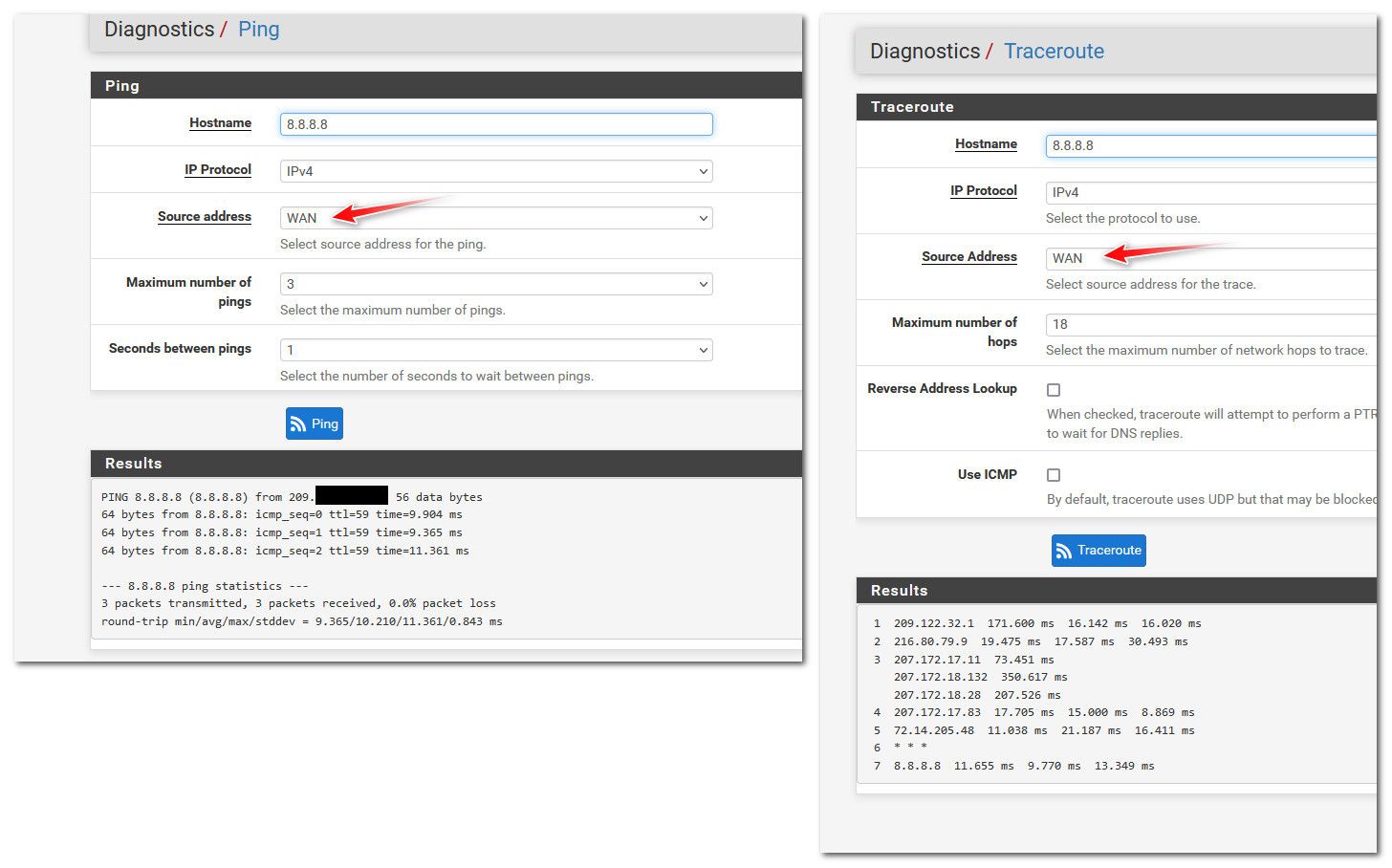
-
@johnpoz I just tried that and get very similar results.
I have not posted a screen shot because I am unsure which information should be removed prior to posting.My TP-Link is definitely in AP mode.
pfBlockerng is working on my pfSense box, ads are being blocked.I have connected my pfSense router LAN to my TP-Link LAN (not WAN, this is according to the official TP-Link instructions).
For my TP-Link router, you have to give its LAN an IP address that lies within the range of your pfSense router, then you disable the DHCP Server feature, then you connect LAN to LAN.
And voila, your TP-Link is now an access point, leaving the hard core routing function to pfSense.Before I put my TP-Link in AP mode, I connected my pc to my pfSense router and I had internet connection as well.
If my internet connection was not going through my pfSense router, pfBlockerng wouldn't work, would it?
I have no idea what is happening with the Gateways.
I am very new to pfSense and greatly appreciate any help that is provided.
-
@Neoveo said in I can't access my USB hard drive that is attached to my old TP-Link WiFi router:
And voila, your TP-Link is now an access point,
And connect it to your network via one of its lan ports vs its wan port. Yup that is how you can turn any wifi router into just an AP.
I see you have some other thread about your gateway issue. But your internet being down or up, doesn't matter for local access..
So one last time - devices on the same network have nothing to do with pfsense.. Nothing.. If you can ping your tplink, or access its gui then you can talk to it..
Here is how networking works... You have a device 192.168.1.x on a /24 which means anything 192.168.1.1 to 254 is on its network, with the .255 being the broadcast for that network, and the .0 being the network or wire..
So a device says hey I want to talk to 8.8.8.8, well that is not on my network.. Need to send that to my gateway (pfsense) so it arps for the mac of its gateway 192.168.1.1 - and sends the traffic to that mac address with a destination of 8.8.8.8... Pfsense being the router says oh, that is my mac address let me look at the traffic - oh that wants to go to 8.8.8.8 let me route it.
Now when said device says hey want to talk to 192.168.1.Y - it says oh that is on my network, let me arp for it, oh here is its mac.. And send the traffic to 192.168.1.Y via that mac address. Pfsense is not involved..
if you can access this tplink gui and ping it.. Then clearly you can talk to it - so accessing any file shares that device might be sharing - has nothing to do with pfsense.. Unless your trying to access it via some fqdn that pfsense provides, pfsense is not involved in you talking to some IP address that is the same network.. Pfsense is the router/firewall to get off a local network and to some other network, be that local or out on the internet. Pfsense dhcp server might hand both of these devices their IPs, but once they have IPs pfsense has nothing to do with them talking to each other..
If your file sharing is not working - its not a pfsense issue.. Maybe your tplink only shares via smb1 and your pc is only wanting to use smb2 or 3.. Windows did turn off smb1 while back..
So your trying to access this file share how exactly?? Some old link on your pc network browser? That maybe points to the tprouters old IP? You should be able to access your share directly with smb:\ipaddress or just \ipaddress in windows..
just directly access \ipaddress vis using some link in your explorer network thing..
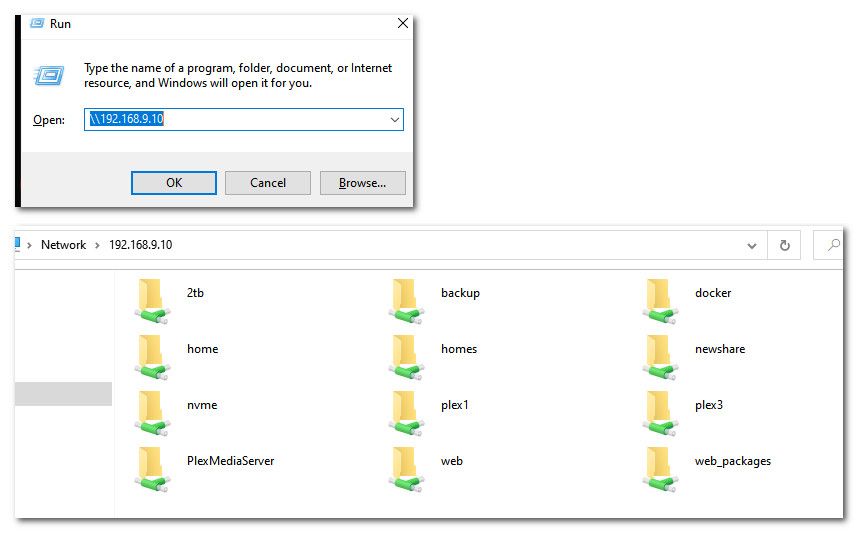
If your using say linux you can access it with smb:\ipaddress
I would suggest you get on the tplink forums for help with their file sharing stuff.. I would be happy to help but I do not have a tplink router with file sharing to play with.
seems the forum removes the double \ those above examples are with double , see my screenshot of how I can access my nas file shares with just the run command and its IP address.
-
@johnpoz thank you for your help, I do appreciate it.
Well two things, first, I got my gateway sorted out (at least for IPv4), secondly, I did finally get access to my USB hard drive that is connected to my TP-Link wifi router.
I followed the instructions provided in this short video:
https://www.youtube.com/watch?v=UoAV7CZcHgU
Now I still have the TP-Link icon under the Network folder and it still is unaccessable, however, I do have my USB hard drive listed elsewhere and I can access it just fine!
-
@Neoveo said in I can't access my USB hard drive that is attached to my old TP-Link WiFi router:
https://www.youtube.com/watch?v=UoAV7CZcHgU
And what did I say to do in the above post ;) hahahha
from the video
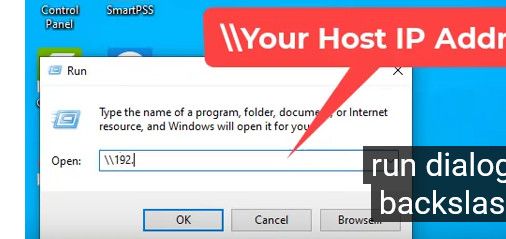
From my post
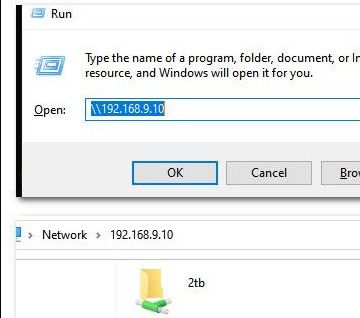
-
@johnpoz well when I used the IP address of my TP-Link wifi router, it failed to work.
It wasn't until I did ran ipconfig and saw a different IP address and used that that it actually worked. -
@Neoveo said in I can't access my USB hard drive that is attached to my old TP-Link WiFi router:
saw a different IP address and used that that it actually worked.
And what IP would that be if your tplink is sharing out the usb drive.. Did it create a different IP for the share - that makes no sense..
-
@johnpoz that's what I've been saying all along, when I try to access the USB SSD, if I use the TP-Link icon found under "Networks" in Windows 10, it tries using the IP address of my TP-Link router followed by ":8200" and it fails to connect.
It tells me that the connection isn't secure and simply will not connect.
If I try using smb:\IP-address of TP-Link, it won't work in Windows 10, it does work in Linux though.If I go to a browser and type in the IP address of my TP-Link router, I can connect no problem.
When I watched the video, that I posted above, it said to use the command ipconfig to get the IP address and use that.
That did and does work.
That IP address is very similar to the TP-Link IP address, except for the last three digits.Can I explain to you what is going on or why this works? Nope.
Am I happy that it does work? Yep! -
@Neoveo said in I can't access my USB hard drive that is attached to my old TP-Link WiFi router:
If I go to a browser and type in the IP address of my TP-Link router, I can connect no problem.
that is exactly what I told you do to, and exactly what that video said.. But then you said it was a different IP..
File shares are not on port 8200.. That is your minidlna running on tplink.. You just need to connect to the IP of the tplink via smb, which would be port 445.. You don't need to call that out, doing a run \ \ IPaddress will do it, or smb:\ \ IPaddress.
None of which has anything at all to do with pfsense.
No duh you wouldn't be able to run ipconfig on the tplink, its a not a windows server..
-
@johnpoz I did not select :8200, that is what Windows 10 automatically chooses and I have no option to edit or otherwise modify that.
I never said I ran ipconfig on the TP-Link wifi router; I ran it in Windows 10 Command Prompt, just like they showed in the video.
And yes, the IP address that I have to use in Windows 10 to connect to my USB SSD is different than the IP address that I use to connect to my TP-Link wifi router.
When I say connect to my TP-Link wifi router I mean access to it's OS, where I can change the settings like wifi password. Connecting to my TP-Link wifi router with it's IP address does not grant me access to the USB SSD; I can see that it's connected, but can't read or write to it.
In Linux, that is a different story, as I mentioned above, I can use sbb://IP-address-for-TP-Link and all is good.
In Windows 10 I have to use a different IP address (where the last three digits are different).Anyway, I am thankful that I am now able to access my USB SSD.
-
@Neoveo said in I can't access my USB hard drive that is attached to my old TP-Link WiFi router:
In Windows 10 I have to use a different IP address (where the last three digits are different).
Sorry but that makes no sense.. Lets say tplink had 2 ips - why would both of them not work.. Are you trying to connect to its old wan IP? Or its lan IP?
Why don't you show the IPs your connecting to.. They are rfc1918, they are useless to anyone out on the internet.
-
@Neoveo said in I can't access my USB hard drive that is attached to my old TP-Link WiFi router:
I ran it in Windows 10 Command Prompt, just like they showed in the video.
That was the machine with a file share.. And how to find the IP to connect to from another machine..
I am glad you have it sorted and can access your usb share..
-
I had an issue where none of my devices could see my wireless MFP. I had to create a DNS resolver host override entry for it and it fixed everything. I have one for my NAS and one for my MFP. I also run SMB on a raspberry pi but it's accessible on everything.

I don't know if your printer needs the same thing.
-
@JonathanLee which has nothing to do with accessing a smb share via the IP.
-
@johnpoz my Raspberry PI I run a Samba share, I never had to make any ACLs for it as it hits the bridge mode AP I guess and that resolves when items ARP out to it. I don't understand why my MFP needed a host override, no matter if it was turned on or not, it needed one to use it. My airport extreme has a USB drive that was slow until I added a host override for that also. Weird right?
https://pimylifeup.com/raspberry-pi-samba/
-
@JonathanLee the only reason you would need a host override is if you wanted to access via some fqdn.. You sure and the hell do not need that to access a smb share via IP.
If I go \ \ IPaddress or smb:\ \IPaddress (spaces because 2 \s together dont show up because it thinks it escape character most likely).
By mfp, you mean multifunction printer? What would that have to do with a smb share?
Why don't you do a sniff when you try and access your smb share via IP.. Do you see any queries for a name, do you see any broadcast for a name?
-
@johnpoz Yes printer, I thought maybe the samba device also needs a host override. I will check why my PI seems to never has issues, the printer uses a different host name so yep hence the need for fqdn host override.
I ran a packet sniffer while I looked at items I have stored in it and it shows samba port 138 being accessed by 192.168.1.31. This is what occurs when I access the share on the raspberry pi.
I use 192.168.1.1/27 so that is my broadcast address 192.168.1.31 so it is just using the broadcast address to access the samba internally and replying to it? It even uses the multicast DNS port 5353 to get stuff done.
Epic and totally amazing to think of a way to do that. seems risky. I do not approve any of that within the ACLs on the firewall.
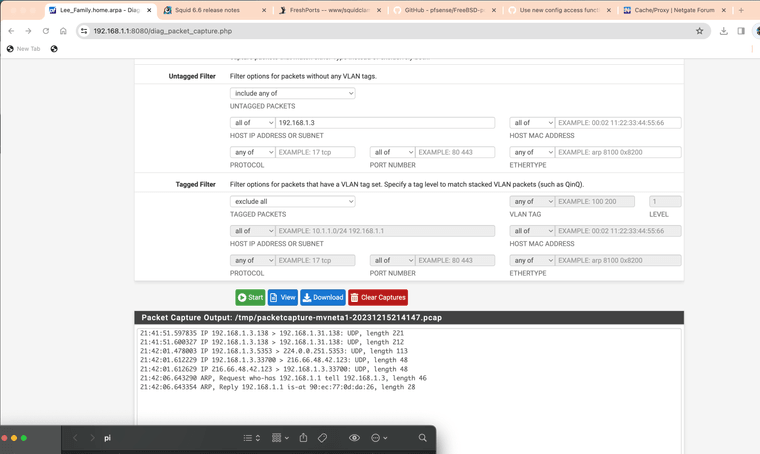
pinging the broadcast address
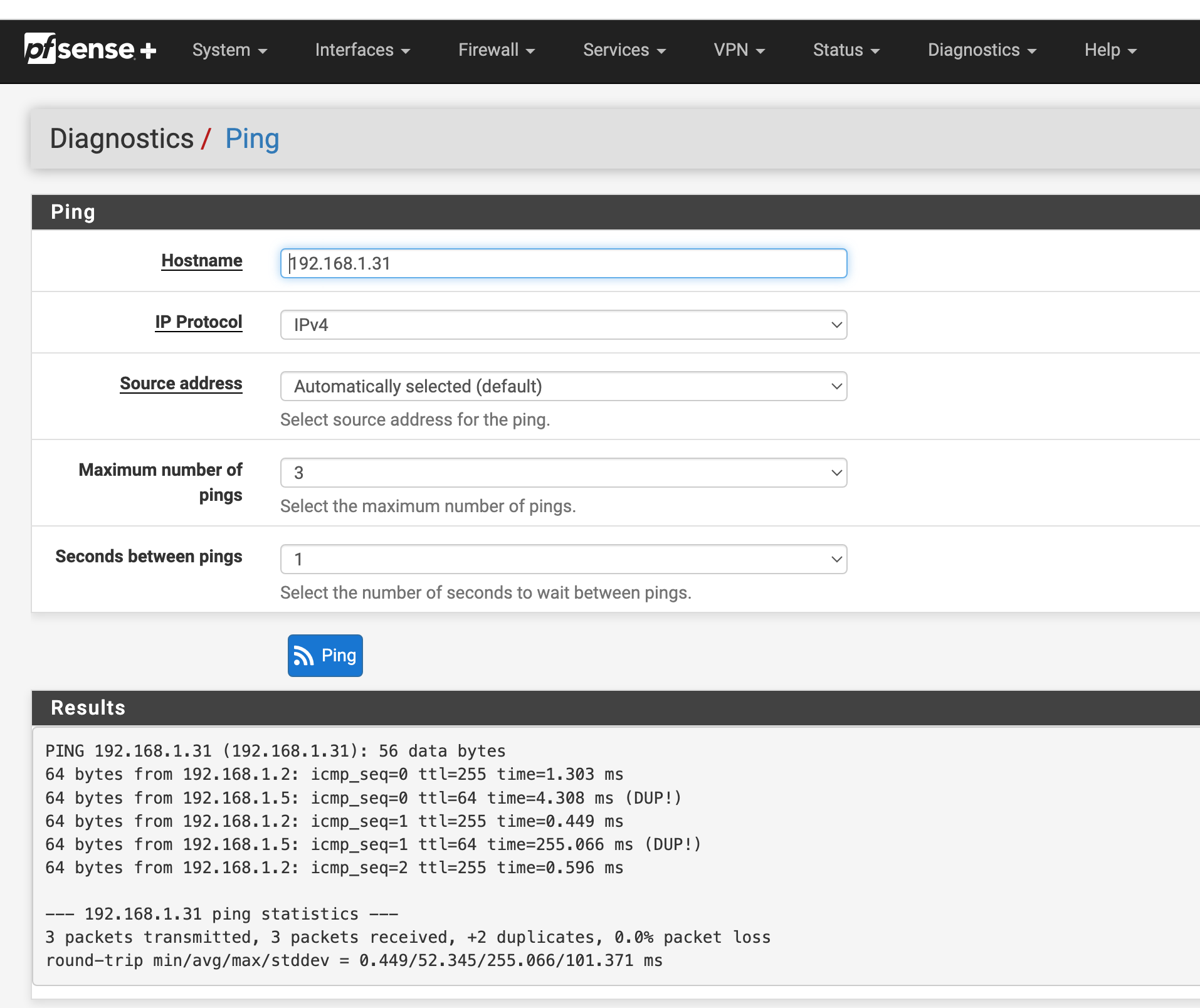
-
@JonathanLee I print to my printer my IP, you can do both - but yeah if your going to use a fqdn, that fqdn has to resolve to an IP or your never going to get there.
-
@johnpoz it's the Cannon software it uses URLs to access the scanner and printer before it sends requests, I can watch it on the proxy, it had this weird hostname, I could input the IP address manually and access it over the browser that's when I thought it needs the hostname to resolve also. The devices use one name and the software uses another name. Hostname override fixed it, that's why I thought his printer or Samba was also using a hostname somewhere
